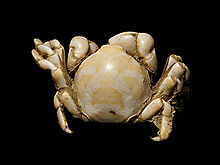Pinnotheres pisum
| Pea crab | |
|---|---|
 |
|
| Pinnotheres pisum ♂ | |
| Scientific classification | |
| Kingdom: | Animalia |
| Phylum: | Arthropoda |
| Subphylum: | Crustacea |
| Class: | Malacostraca |
| Order: | Decapoda |
| Infraorder: | Brachyura |
| Family: | Pinnotheridae |
| Genus: | Pinnotheres |
| Species: | P. pisum |
| Binomial name | |
|
Pinnotheres pisum (Linnaeus, 1767) |
|
| Synonyms | |
|
Pinnotheres cranchii Leach, 1815 |
|
Pinnotheres cranchii Leach, 1815
Pinnotheres latreilli Leach, 1815
Pinnotheres modiolae Costa, 1840
Pinnotheres modioli Leach, 1814
Pinnotheres mytilii Leach, 1814
Pinnotheres mytilorum Leach, 1814
Pinnotheres varians Leach, 1815
The pea crab, Pinnotheres pisum, is a small crab in the family Pinnotheridae that lives as a parasite in oysters, clams, mussels, and other species of bivalves.
Pea crabs are small crustaceans about the size of a pea or dime, with a "smooth dorsal surface of the carapace, or upper exoskeleton". The exoskeleton of males is hard and circular and has eyes and antennae extending from their fronts, and the chelipeds are more robust in males than in females, which have more elongated chelipeds. The bodies of the female pea crabs are often translucent and show the inner organs and gonads as yellow and red, with the males being a "more yellowish-grey with patches of brown".
The relationship between the pea crab and its host is one of parasitism, rather than commensalism, since the host may be harmed by the crab's feeding activities. The pea crab solely relies on its host for food, safety, and oxygen.
Pea crabs have a variety of hosts, the most important of which are mollusks. The pea crab lives in the mantle cavity of these hosts. Other hosts, in addition to oysters, include sea urchins and sand dollars.Pinnotheres can be found inside sand dollars, in the rectum of sea cucumbers, in the tubes of parchment worms, in the burrows of mud shrimp, or in the gills of sea squirts.
...
Wikipedia
